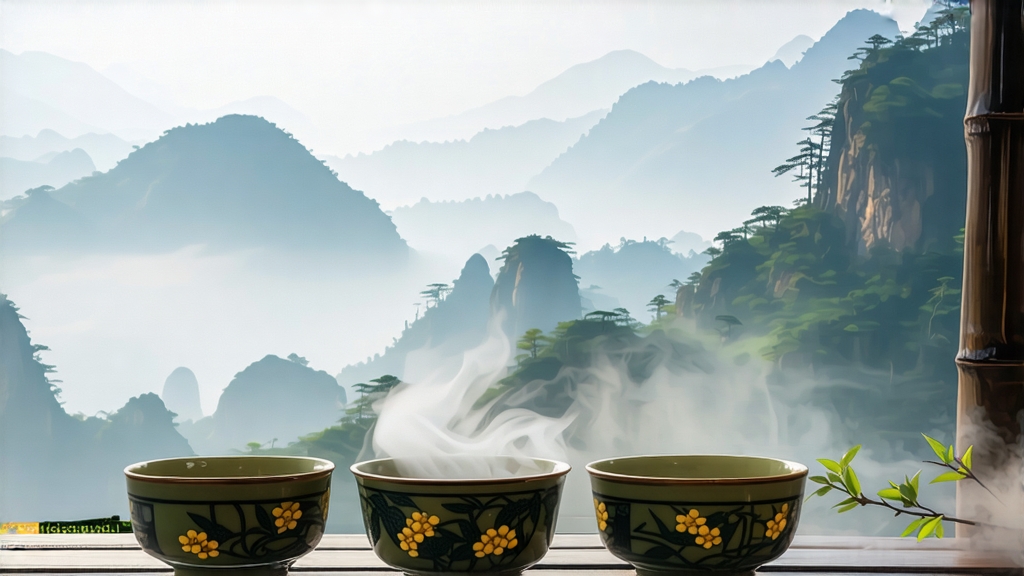
Tucked high in the mist-veiled Dabie Mountains of western Anhui Province, a tea once reserved for emperors still quietly resists the march of time. Huoshan Huangya—literally “yellow bud of Huoshan”—is the least-known yet most aristocratic member of China’s six great tea families. While green tea commands the spotlight and pu-erh fuels collectors’ frenzies, Huoshan Huangya lingers in a twilight zone of flavor, suspended between the freshness of spring greens and the mellow depth of aged whites. To encounter it is to taste a vanished court etiquette, a slow craft that demands one watch the clock with the same reverence a violinist gives to a Stradivarius.
Historical whispers place the tea’s birth during the Tang dynasty (618-907), when Huoshan County served as a staging post on the mountain road linking the imperial capital to the tea-rich south. Caravans rested at the foot of Jinji Mountain, trading salt, silk, and the earliest “small-leaf yellow” picked by Buddhist monks who believed the pale color signified spiritual purity. By the Ming dynasty, local gazetteers record tribute missions bearing “golden shoots wrapped in damask” to the Forbidden City; the Qianlong Emperor allegedly refused all other beverages once the snow-melt season began, convinced that only Huangya could “clear the palace air of lantern smoke.” Republican-era turmoil and the subsequent wars nearly erased the craft: gardens were abandoned, seed gardens lost, and the secret of “menhuang”—the slow heaping that turns green leaf to topaz—survived only in the memory of three ageing masters. When Deng Xiaoping’s 1978 reforms reopened China, a retired agronomist named Mr. Dai Zhenhua spent seven years crawling through mountain hamlets, coaxing cuttings from ancient shrubs and piecing together fragmentary oral records. The first commercial batch of revived Huoshan Huangya reached Beijing in 1985; today, barely 180 hectares are under authentic cultivar, yielding perhaps 15 tonnes a year, a thimbleful in a nation that harvests three million tonnes of tea annually.
Botanically, the tea belongs to the small-leaf China-type Camellia sinensis var. sinensis, locally called “jiuye zao” (nine-leaf early) because the bush unfurls nine serrated leaves before pausing. The prized pluck is the “inch-long sparrow’s tongue” picked for only ten mornings after Qingming festival, when buds swell but remain unopened, sheathed in down that catches light like frost. Three grades are recognised by the Huoshan Bureau of Agriculture: Special Grade (80 % single buds, 20 % one bud and one leaf), Grade One (equal bud-to-leaf ratio), and Grade Two (one bud and two leaves). Connoisseurs hunt the pre-Qingming Special Grade, yet many prefer the slightly later Grade One, arguing that a whisper of leaf adds orchid complexity without sacrificing silkiness.
Crafting Huoshan Huangya is a choreography of heat, humidity, and stillness that stretches across three nights and two days. The newly picked shoots are spread on bamboo trays and withered for four to six hours in weak mountain sunlight filtered through reed screens; the goal is to evaporate roughly 10 % moisture while preserving the bud’s silvery fuzz. Next comes the first firing—“shaqing” in standard tea lexicon yet here performed at a surprisingly low 80 °C on a darkened wok brushed with tung oil. The master’s palm hovers half an inch above the leaf, feeling for the moment when buds become pliable yet refuse to stick to the skin; one lapse and the enzymatic soul needed for menhuang is scorched away. While still warm, the leaf is stacked in linen sacks and left to suffocate—this is menhuang, literally “yellowing,” the step that distinguishes yellow tea from green. Over the following 24–36 hours the piles are turned every 90 minutes; temperature is maintained at 28–32 °C and humidity at 75 %, coaxing a gentle re-oxidation that turns chlorophyll into pheophytin and releases a cascade of aromatic lactones. When the leaf edges curl like a monk’s slippers and the aroma shifts from fresh pea to warm pumpkin, the pile is broken up and given a second, hotter firing at 100 °C to lock in color. A final slow charcoal bake over huigan charcoal (oak wood prized for its smokeless ember) reduces moisture to